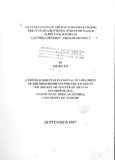| dc.description.abstract | The purpose of this study was to evaluate the comrnunitys' management of water supply
facilities in Gachoka Division, Mbeere District. Three factors were considered in this study,
the reliability of the improved facilities, community participation and institutional framework.
The study: s objectives were; to explore the different sources of water and ascertain the reliability
of improved water supply facilities vis-a-vis the unimproved indigenous sources; to investigate
the community's role in the development of the water sources and the effect this has on the
sustainable management of the improved water sources and thirdly, to investigate the
community's institutional framework by assessing the strength of gender roles in group
activities, training and networking. The management of the water supply facilities is expJained
within the context of the social systems theory. Data collection techniques included the use of
a standard questionnairewhich was orally administered to one hundred (100) sampled
respondents, two focus-group discussions, key informants, desk studies and unstructured
interviews. Participatory Research Approach (PRA) was adopted in the process of collecting
the data.
The hypotheses that were formulated are; the improved water supply facilities are reliable
sources of water and are more preferred and sustainably maintained than the unimproved
indigenous water sources; that community participation in design and implementation of the
water sources is likely to bring about sustainable maintenance of the water supply facilities
and.that the development of a strong institutional framework will result in sustainably
maintained water sources.
Analysis of the data showed that two improved water supply facilities (boreholes and dams)
provide water throughout the year while the rest of the sources (rock catchment tanks, roof
catchment tanks, streams and wells) are seasonal in that they provide water during and shortly
after the rains. The study found out that quantity and accessibility count more than quality.
Another finding is that the ~mun'ity members were by-passed during the development
process, hence, never identified themselves with the improved water supply facilities. This
(xii)
resulted in the facilities being poorly maintained. The trend of unsustainability has in the case.
of boreholes been tackled through the community mobilization exercise involving the training
of caretakers, the committee members as well as the formation of the grass-root organizations.
There is a significant trend towards involving women in the management of the water resources.
Given the study findings, it is clear that the community: members are capable of sustainably
managing .those facilities if directly involved in thei'r planning and maintenance. The study
recommends the participation of the community members in future planning and development
of projects. | en |

